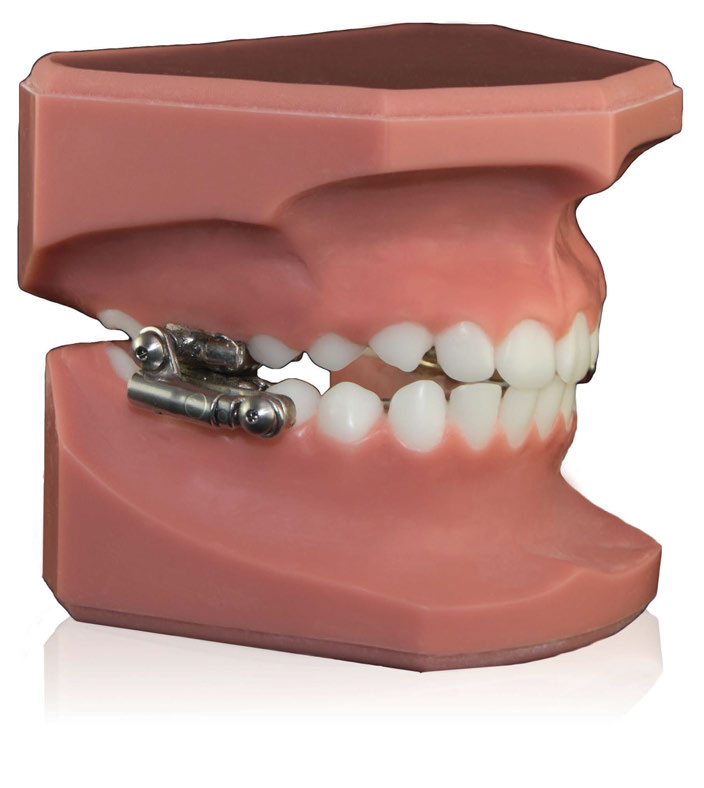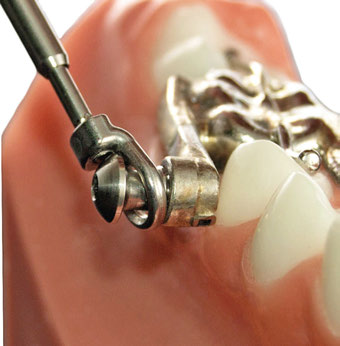A review of the Herbst appliance and the design evolution of the last 30 years
 The Herbst™ appliance was introduced in 1909 by Dr. Emil Herbst. Dr. Herbst was a German orthodontist who contributed greatly to the orthodontic profession. He also introduced the rapid palatal expansion device. The original Herbst appliance mechanism was a rod and tube device that is still used on some designs today. However, the original rod and tubes were made from either silver or gold. Dr. Herbst would anchor to the upper first permanent molars and lower first bicuspids with a lingual arch on both arches. The lower lingual arch would be contoured between the interproximal of the first and second molars.
The Herbst™ appliance was introduced in 1909 by Dr. Emil Herbst. Dr. Herbst was a German orthodontist who contributed greatly to the orthodontic profession. He also introduced the rapid palatal expansion device. The original Herbst appliance mechanism was a rod and tube device that is still used on some designs today. However, the original rod and tubes were made from either silver or gold. Dr. Herbst would anchor to the upper first permanent molars and lower first bicuspids with a lingual arch on both arches. The lower lingual arch would be contoured between the interproximal of the first and second molars.
Original Herbst designs had limited lateral movement that restricted the patient’s speech and chewing movements. They were also very bulky, and the extension arms were longer. The oversized appliance was not aesthetic and caused irritation to the cheeks and lips where the mechanisms were secured.
Over the years, Herbst appliances have seen several anchorage designs. Dr. Hans Pancherez utilized cast frameworks that were bonded to the teeth to maintain total anchorage. He also utilized bands as anchorage in 1979. Dr. Raymond Howe patented the Acrylic Splint Herbst design on the upper and lower arches in 1982. Initially these splints were bonded to the teeth. This technique is still utilized today, but the splints are generally removable. Dr. Alton Bishop and some other orthodontists utilized mesh pads that were bonded to the buccal and lingual of the upper and lower teeth in the posterior and the lingual of the anterior teeth. Dr. Langford introduced utilizing crowns for anchorage in 1980. Dr. Terry Dischinger reintroduced his bioprogressive technique with crowns in 1987. Bands, crowns, and crowns with the occlusal removed (ROC crowns) are the main anchorage systems today. The most popular anchorage system at Specialty Appliances is the ROC crown. It combines the strength of a crown with band-like removal.
Dr. Dischinger has been very instrumental in promoting and teaching the Herbst appliance treatment to several orthodontists over the last 20-plus years. His bioprogressive approach utilized fixed treatment combined with the Herbst appliance, which is the industry standard today. I was fortunate enough to travel with Dr. Dischinger for 9 years, promoting the Herbst appliance and attending 33 of his hands-on courses.
The traditional rod and tube mechanism is still utilized by several clinicians today, but other designs have evolved in the Herbst market. The Flip-Lock™ mechanism was introduced in 1996 by Dr. Miller. In 2003, Dr. Steve Hanks introduced the HTH™ telescoping Herbst mechanism with a ball and socket design. Specialty Appliances introduced the MiniScope™ Herbst with the AppleCore® screws in 2004. In 2009, Dr. Dischinger introduced his Molar to Molar™ Herbst mechanism. The latest design on the market is the M4™ MiniScope® mechanism introduced by Specialty Appliances in 2011. This four-part telescope mechanism is already used by over 65% of Herbst customers at Specialty Appliances.

Specialty Appliances and the new M4 Herbst Telescope addresses many issues related to Herbst treatment. The M4 utilized along with ROC crowns and AppleCore® screws are becoming an industry standard. The AppleCore screw, invented by Specialty Appliances in 2004, offers up to 40 degrees of lateral movement. This gives the patient more natural function and greatly reduces breakage due to the freedom in lateral excursions.
The M4 design has unique features that solve many issues in Herbst treatment. One of those being the size of the mechanism, which is offered in 16 millimeter and 19 millimeter sizes. The shorter mechanism is placed in the temporal and masseter muscle area and away from the pterygoid and buccinator muscle areas. In addition, the M4 design is angled anteriorly on the upper eyelet to prevent tissue irritation. The telescope design opens 65 millimeters, offering the greatest vertical opening of any telescope on the market today. Why is this feature so important? If patients are limited by the vertical opening, they will either break the appliance or pull the lower crowns off of the teeth. The M4 Herbst is placed parallel to the occlusal plane, allowing the greatest lateral movement and eliminating unwanted vertical forces that can intrude teeth. If intrusion is wanted in a high-angle patient, then the lower arch cantilever arm is placed sub-gingivally to create a vertical force. Not only does the M4 Herbst improve patient comfort, but it also has the least amount of breakage. These benefits have greatly improved the Herbst treatment experience for both doctor and patient.
Stay Relevant With Orthodontic Practice US
Join our email list for CE courses and webinars, articles and mores

 As Vice President and partner at Specialty Appliances, Arlen Hurt, CDT, has dedicated the past 30 years to orthodontic appliance innovation. Mr. Hurt is recognized as an awardwinning inventor, published author, and national orthodontic speaker. Arlen is best known as one of the most dependable resources for orthodontists everywhere.
As Vice President and partner at Specialty Appliances, Arlen Hurt, CDT, has dedicated the past 30 years to orthodontic appliance innovation. Mr. Hurt is recognized as an awardwinning inventor, published author, and national orthodontic speaker. Arlen is best known as one of the most dependable resources for orthodontists everywhere.
